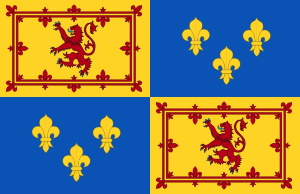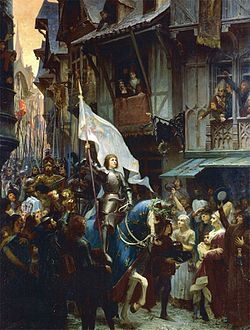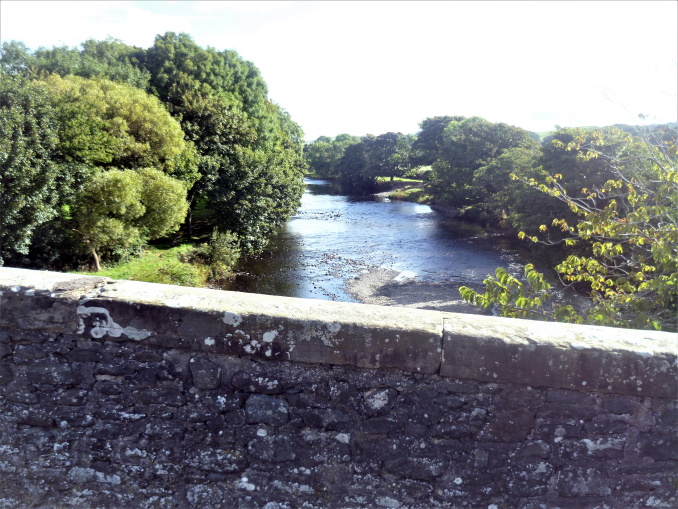Echoes of the “Auld Alliance” and Joan of Arc reverberate around ruins of Ardstinchar Castle in Scotland

Above the Scottish coastal village of Ballantrae (Scottish Gaelic: Baile na Tràgha) stands the ruin of Ardstinchar Castle, a reminder of Scotland's Auld Alliance. The Auld Alliance (Scots for "Old Alliance"; Scottish Gaelic: An Seann-chaidreachas) was an alliance made in 1295 between the kingdoms of Scotland and France. The uniting factor in this long-lasting association between the two countries, which was never actually officially revoked, was their numerous conflicts with England. Ardstinchar Castle was built in the fifteenth century by Hugh Kennedy, one of the sons of Sir Gilbert Kennedy of Dunure. He was known as "Friar Hew" as he was a fully-ordained Dominican priest. Also he is famously described as Joan of Arc's (French: Jeanne d'Arc) Scottish Captain. There is an excellent biography available about this fascinating man written by Jean Brittain Hugh Kennedy of Ardstinchar: Joan of Arc's Scottish Captain.
The story of Hugh Kennedy is quite remarkable. A journey from Priest, to soldier, diplomat, counsellor to kings, to Archdeacon of St Andrews and much more in between. Perhaps the most fascinating part of his tale is the time he led troops for Joan of Arc at the Siege of Orléans (1428–1429). This was during what is known as the Hundred Years' War. Which was a series of conflicts in Western Europe from 1337 to 1453. It was waged over the right to rule the Kingdom of France between the House of Plantagenet and its cadet House of Lancaster, rulers of the Kingdom of England, and the House of Valois. Scottish forces served with the French military throughout most of the Hundred Years' War. Joan of Arc (c. 1412 – 30 May 1431), nicknamed "The Maid of Orléans", is considered a heroine of France for her role during the third and final phase (1415 - 1453) of the War.

Born to a peasant family, at Domrémy in northeast France, Joan claimed to have received visions of the archangel Michael, Saint Margaret, and Saint Catherine of Alexandria instructing her to support Charles VII the King of France and recover France from English domination. Charles VII sent Joan to the Siege of Orléans as part of a relief army. The Siege of Orléans took place at a time when the city held strategic and symbolic significance to both sides of the conflict. Joan joined a convoy assembling at Blois, that aimed to bring supplies to Orléans. It was from Blois that Joan issued her famous messages to the English siege commanders, calling herself "the Maiden" (La Pucelle), and ordering them, in the name of God, to "Begone, or I will make you go". She was part of a small force that managed to bring provisions into the city. Joan paraded periodically around the streets of Orléans, distributing food to the people and salaries to the garrison, until the siege was finally broken.
During his time fighting in the Hundred Years War Hugh Kennedy, along with many other Scottish fighters, distinguished himself in a number of encounters. Amongst which was his involvement at the Battle of Bauge in 1421 where a Franco - Scots army inflicted a major defeat on the English. He took part in the Siege of Montargis in 1427 where a French relief army under Jean de Dunois routed an English force led by the Earl of Warwick. Also in 1428 before the arrival of Joan of Arc, he had managed to get provisions into Orleans. He was at the Battle of the Herrings in 1429 close to the town of Rouvray just north of Orléans. Here an attempt was made by French and Scottish forces to intercept a supply convoy headed for the English army at Orléans.

He took part in other military engagements after the Siege of Orléans. However, it was, perhaps the breaking of the Siege and his involvement with Joan of Arc, that comes to mind when thinking of Hugh Kennedy. The Siege of Orléans was a significant turning point in the fortunes of the French royal army in the Hundred Years' War. It was a major victory and also the first while Joan of Arc was with the army. Hugh Kennedy was with Joan of Arc at the Thanksgiving in Orleans Cathedral. Scottish fighters, commanded by Sir Hugh Kennedy, were with Joan in her last victory at Lagny. On 23rd May 1430 Joan of Arc was captured during the fight to defend Compiégne and handed over to the English. Subjected to a clearly unfair trial and found guilty on spurious charges, she was burned at the stake on 30 May 1431, dying at about nineteen years of age.
Hugh Kennedy died in 1454 after what can be described as a life of adventure with many twists and turns. His descendants lived in Ardstinchar Castle for more than a century. Mary, Queen of Scots visited the castle in 1563. By 1770, sadly the castle had fallen into disrepair. Stones from it were used for the construction of a three-arch bridge over the River Stinchar, as well as several houses and an inn in Ballantrae.
Though little remains of the castle today, its ruins still seem to hold a strong sense of presence, perhaps that of the man that built it. Standing as it does on a rocky hill over the River Stinchar that runs through Ballantrae. Even the name of the River Stinchar is steeped in mystery. Some think it is derived from old Gaelic: 'Staing Aos Ath Irr' meaning 'The River of the Sacred Place of the Druids'. For many people Ballantrae is most well known as the setting for the novel The Master of Ballantrae by Robert Louis Stevenson published in 1889. However, the village and the castle above it also stand as a reminder of Hugh Kennedy of Ardstinchar: Joan of Arc’s Scottish Captain.

- Scottish
- English





